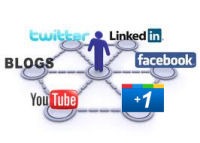
Building an online community with social media is anything but easy, and sometimes the ROI isn?t necessarily obvious or easily identified. This is why many small businesses avoid it altogether, and to their detriment. Social media?s true benefit comes from reputation and customer retention, not from immediate sales. This is a far more important thing to invest in long term.
Here are some of the challenges you need to overcome in order to make it work:
1. Time
Building an online community can seem like a daunting task, especially when there are so many networks to choose from and it?s not entirely clear which ones you should invest most of your time in. Finding time to build relationships on social networks can be difficult. When done improperly, it can also become a waste of time.
To get things rolling smoothly, consistently, and without wasting time, you?ll need to develop a social media schedule. It should meet these requirements:
- A way to find funny, surprising, or otherwise shareable pieces of content quickly
- A set time to post this content to Facebook each day or every other day
- Two or three times each day to check Facebook for comments or questions and to respond to them quickly and personally
- Two or three times to check Twitter for questions related to your business and respond to them
- One time each day to email a prominent blogger, tweeter, or Facebook page owner
 Make sure your social media time is spent on times when people are active on these networks so that the effort doesn?t go to waste. As reported by Mashable,? bit.ly has released some data on the best and worst times to share links on popular social networks, from Facebook and Twitter to blogging site Tumblr. If you are using or thinking of using Pinterest, make use of this Pinterest cheat sheet to give you more help. Tweriod.com is also a great tool that analyses your data and provides you with the ideal times to Tweet.
Make sure your social media time is spent on times when people are active on these networks so that the effort doesn?t go to waste. As reported by Mashable,? bit.ly has released some data on the best and worst times to share links on popular social networks, from Facebook and Twitter to blogging site Tumblr. If you are using or thinking of using Pinterest, make use of this Pinterest cheat sheet to give you more help. Tweriod.com is also a great tool that analyses your data and provides you with the ideal times to Tweet.
Anyway, if you are doing this properly, you shouldn?t be devoting more than one hour to social media each day (two hours if you are heavily involved). If more time is invested in social media, there is a good chance you need to streamline your process or hire somebody as a full time social media personality.
2. Connecting
Many businesses fail to see growth in their social following, and this is often because they fail to connect with their audience. The problem is that social media is a platform for two-way communication, not for broadcasting. Business owners have become so accustomed to advertising as their primary mode of communication that they have trouble connecting with people as people.
One of the biggest changes you can make to resolve this problem is to focus specifically on questions. At least half of your interactions should be about either asking or answering questions. Generally, you will start by answering questions and gradually move toward asking them as your audience grows. Use questions as a way to build credibility and trust, not as an opportunity to make a sale.
Be sure to respond to comments so that people know you are listening.
Finally, build some solid give and take relationships with influential people. It is not as difficult as you might think to build a casual relationship with a blogger or a widely followed tweeter. All it takes is a willingness to help them and talk to them like human beings, as well as an acknowledgment that some people will respond and others won?t.
3. Content
Producing content is probably one of the most difficult aspects of social media campaigning, to the point that many businesses skip out on this part altogether. This isn?t always a problem. It is possible to build a strong community by asking and answering questions, working with influencers, and sharing the viral content of others.
If you don?t have time to produce your own content, it?s not necessarily a death sentence for your social media profile.
However, it?s worth recognizing that a small business doesn?t necessarily have to produce magazine or newspaper quality content to give people a reason to subscribe. For example:
- A few short and thoughtful paragraphs each day can be a very successful strategy. Just look at Seth Godin.
- Memes such as those that propagate through Reddit and Imgur don?t take a lot of time to make. They just need to be funny and relevant.
- Every email you send or receive can be mined for insights that can go into a piece of content.
- Conversations that you have with your followers and influencers can be inspiration for content, or transformed directly into content.
- Content that involves contributions from other people can improve your quality and your exposure
- Photos are another good source of content
If you want to take things to the next level, you can start mining tough data sources like peer reviewed literature, industry insiders, books, and government and educational websites for raw data. This level of dedication is impossible for your daily content, but can be used to produce highly original and useful content on a monthly or quarterly basis.
Another very powerful source of content is your own business?s operations. Much of the data that you feel should be kept proprietary may actually be more useful as marketing material. Insider data is often heavily shared and linked to by influencers. Obviously, you need to weigh the pros and cons of this.
It?s not necessarily easy to conquer time, connections, and content, but when you do, the results are phenomenal. The long term value is far higher than most channels for the amount of time and money spent, provided that your process is streamlined. Focus on building a simple and repeatable schedule and communicating to people like a human being.
See also: Free Social Media Guides
Can you think of other challenges small businesses face with social media?
Source: http://www.iblogzone.com/2012/11/challenges-small-businesses-face-with-social-media.html
lollapalooza lineup joss whedon ronnie montrose melissa gilbert dancing with the stars dandelion wine cough matt groening
No comments:
Post a Comment
Note: Only a member of this blog may post a comment.